The Retail Radeon HD 7870 Review: HIS 7870 IceQ Turbo & PowerColor PCS+ HD7870
by Ryan Smith on March 19, 2012 9:00 AM EST- Posted in
- GPUs
- AMD
- PowerColor
- Radeon HD 7000
- HIS
Overclocking: Power, Temp, & Noise
Of course no review of the Radeon HD 7000 series would be complete without a look at overclocking. In all of our testing AMD’s Southern Islands GPUs have proven to be impressive overclockers, including the reference 7870. In our 7870 review we hit 1150MHz on the core and 5.4GHz for the RAM, which made for a rather hefty overclock.
Our retail cards in turn one up the reference 7870. For core overclocking we hit 1200MHz on both cards, which is a 100MHz (9%) overclock over their factory overclocks, for a total of a rather incredible 200MHz (20%) overclock compared to a 7870’s stock clock. Given the overclockability we’ve seen for the Pitcairn GPU it’s unlikely that HIS, PowerColor, and other partners are having to do too much work for their factory overclocked cards, but we believe there’s at least some simple binning going on here, which would explain the better overclocks we’re seeing on these retail cards.
Interestingly this is all without overvolting of any kind. There still aren’t any tools capable of voltage control on the AMD reference PCB, so the limit is what you can get at reference voltages. If Pitcairn responds well to overvolting though, things could get very interesting in the future.
Memory overclocking wasn’t quite as eventful however, largely due to the fact that all of our 7870s use the same PCB and the same memory chips. Beyond 5.4GHz performance starts to plateau due to error correction. This is still a 500MHz (10%) memory overclock for the PCS+ HD7870 and a 600MHz (12%) memory overclock over the IceQ Turbo 7870 and stock 7870, but at this point GPU overclocking is eclipsing memory overclocking.
So what does a core clock of 1200MHz and a memory clock of 5.4GHz get you? In short, a lot of performance. But first, a look at power, temp, and noise.
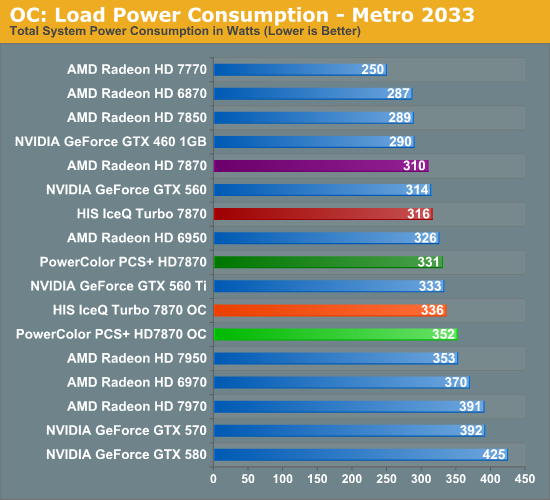

The power costs of this overclock are rather consistent for both cards. Under Metro these overclocks drive up power consumption by about 20W at the wall. Meanwhile under OCCT with PowerTune set at +20% (228W), power consumption jumps up by roughly 30W, which is more in line with the shift in PowerTune limits to prevent throttling than it is from the overclock itself. All things considered these aren’t massive increases in power consumption, but on top of the factory overclock it adds up. The PCS+ HD7870 in particular is 42W over the reference 7870 in Metro, which goes to show that while overclocking without a voltage increase doesn’t drive up power consumption as quickly, it can certainly have an impact.
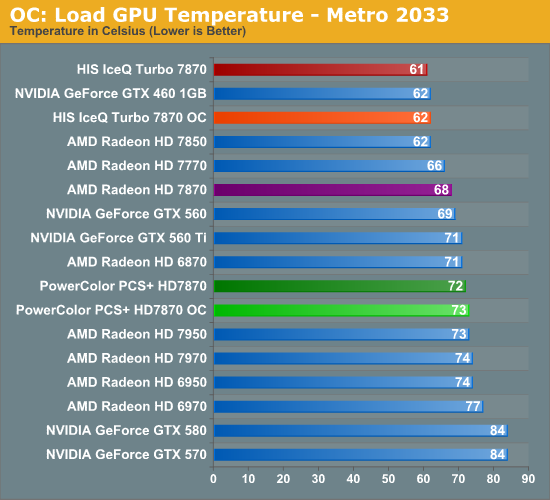
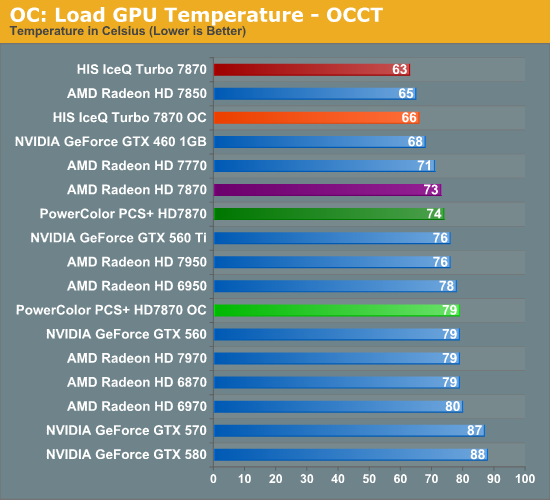
With the increase in power consumption comes the requisite increase in temperatures. At 79C under OCCT the PCS+ HD7870 is still well within our comfort zone, and this is the pathological case. Under Metro the increase is but a fraction, with temperatures going up by only a single degree.
Meanwhile the IceQ Turbo 7870 continues to flaunt its unusual cooler here. Under Metro it reaches a still relatively chilly 62C, and even OCCT can only get the card up to 66C, which is practically unheard of for a 190W card. Once HIS gets voltage controls working, voltage tweakers may very well end up having a field day here as there’s a good 15C+ of thermal headroom to play with on the GPU. Assuming of course that the VRM circuitry on the AMD reference PCB can hold up to further abuse.
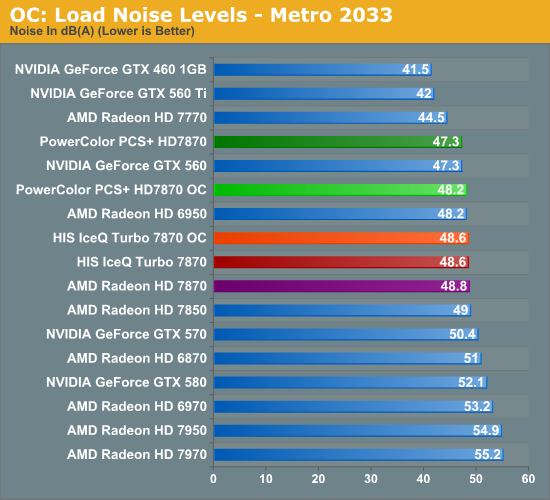
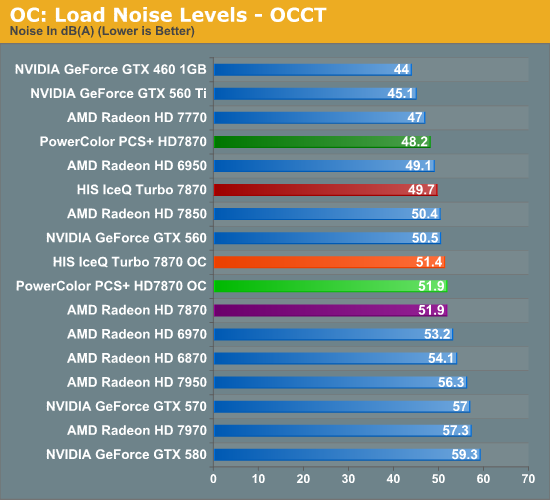
Finally, when it comes to noise the fact that temperatures don’t significantly rise under Metro means that there’s a minimal shift in load noise here. Our double overclocked cards are still quieter than the reference 7870, which in the case of the IceQ Turbo is thanks in large part to its low temperatures requiring no further work from the fan. Meanwhile the PCS+ gives up most of its noise advantage here. OCCT on the other hand finally sees every card jump up above 50dB, with both cards tying or beating the reference 7870 by a fraction of a decibel.
Ultimately the second overclock does have an impact on power consumption, but particularly when paying attention to gameplay as opposed to the pathological OCCT, the cost is very cheap. Unless you’re on a specific power budget or need to stay below the equivalent of 50dB on our charts, there’s still a fair bit of headroom to play with on these retail 7870s.










53 Comments
View All Comments
Death666Angel - Monday, March 19, 2012 - link
Then why include the 7970 at all since that isn't an option? Just so people can compare their e-peens against higher end cards which in turn can be overlocked so the comparison is moot anyway?kyuu - Monday, March 19, 2012 - link
The point is to show that you can achieve equal or better performance to a higher-end stock card with this particular card, that is the one being reviewed, over clocked. You're making up some theoretical audience that is somehow misreading it and arguing that they're being mislead, but I don't think those people actually exist. No one is claiming you can't over clock the more expensive card, nor is it really relevant.kyuu - Monday, March 19, 2012 - link
Sorry, it was actually the OP who imagines there is some "inept" audience misreading it, not you, so my apologies. However, there's still no need to include OC figures for every single card (making a huge, messy, difficult-to-read graph). This article is about two particular products. They are then compared to other stock cards, with some OC figures presented for good measure. There's nothing to complain about here.Ryan Smith - Monday, March 19, 2012 - link
Funny enough several people asked why we didn't include the 7970 in our This Just In article.Iketh - Monday, March 19, 2012 - link
how is comparing an OC card to a higher stock card determining value???? You have to compare to the higher card's overclock... why is this difficult to understand?Ryan Smith - Monday, March 19, 2012 - link
Hi Peanutsrevenge;The primary goal we have with our overclocking comparison isn't to say any given card is more or less superior because of how far it can overclock, but rather we're trying to give the appropriate framing and significance to our overclocking results. An overclocked 7870 will never be better than an overclocked 7950; the fact that an overclocked 7870 can reach the performance of a stock 7950 is what's important. The only question I'm trying to answer here is "what new performance level can you reach with overclocking".
-Thanks
Ryan Smith
bassface2001 - Monday, March 19, 2012 - link
I agree with the original sentiment that overclocked versus stock is a silly comparison. Since whatever is stock can be overclocked as well. Budget reasons don't add validity to this type of comparison either. If you're limited by budget then it doesn't matter how close or far away an overclocked product is to the next one up when you can't afford the next step up.What may be of interest would be percentage overclocks between different levels of product. This then answers the question of "what new performance level can you reach with overclocking" with fair comparisons acrosss the board.
So if the entry level can be overclocked by 5% the midrange by 25% and the highend by 10%. The mid range may present the best value over the other two or it may not but the reader has a like with like comparison to make an informed decision.
Death666Angel - Monday, March 19, 2012 - link
"The only question I'm trying to answer here is "what new performance level can you reach with overclocking"."Fair enough. :-) And you are doing a great job btw.! But that just isn't the type of question I would set regarding OC ability of different cards. :-)
For that reason, I like the overclockersclub.com reviews, because they have a database of all overclocked cards and compare new overclocked cards against old overclocked cards. It's still not technically "apples to apples" since overclocks vary by a lot. But it is more useful to me and more what I expect than anandtechs treatment of overclocks. :-)
Ryan Smith - Monday, March 19, 2012 - link
It's fair criticism.The reality is that we're sticklers for the scientific method, which means we need as few variables as possible. To keep a DB of overclocked video cards we would need to rebench every overclocked card every time a new driver with a measurable performance impact came out. This isn't practical for purposes of time, nor for that matter do we keep these retail cards on hand. The alternative would be to compare overclocks across different drivers, and we would rather give you fewer accurate numbers than to make such a comparison.
-Thanks
Ryan Smith
Frallan - Tuesday, March 20, 2012 - link
Thanks for the replys Ryan,first its very nice to have the dudes acctually sitting with the hardware and performing the tests communicating with us like you are.
Scondly regarding the discussion at hand I just want to give you my support since it is very valueble to have the tests as you do them. This is bc I will be looking for the best possible effect out of a given budget framework since I dont have the funds to buy whatever I want whenever I want it.
Keep up the good work and Anandtech will remain my main tech reference site another 10 years.
BR
/Fredrik